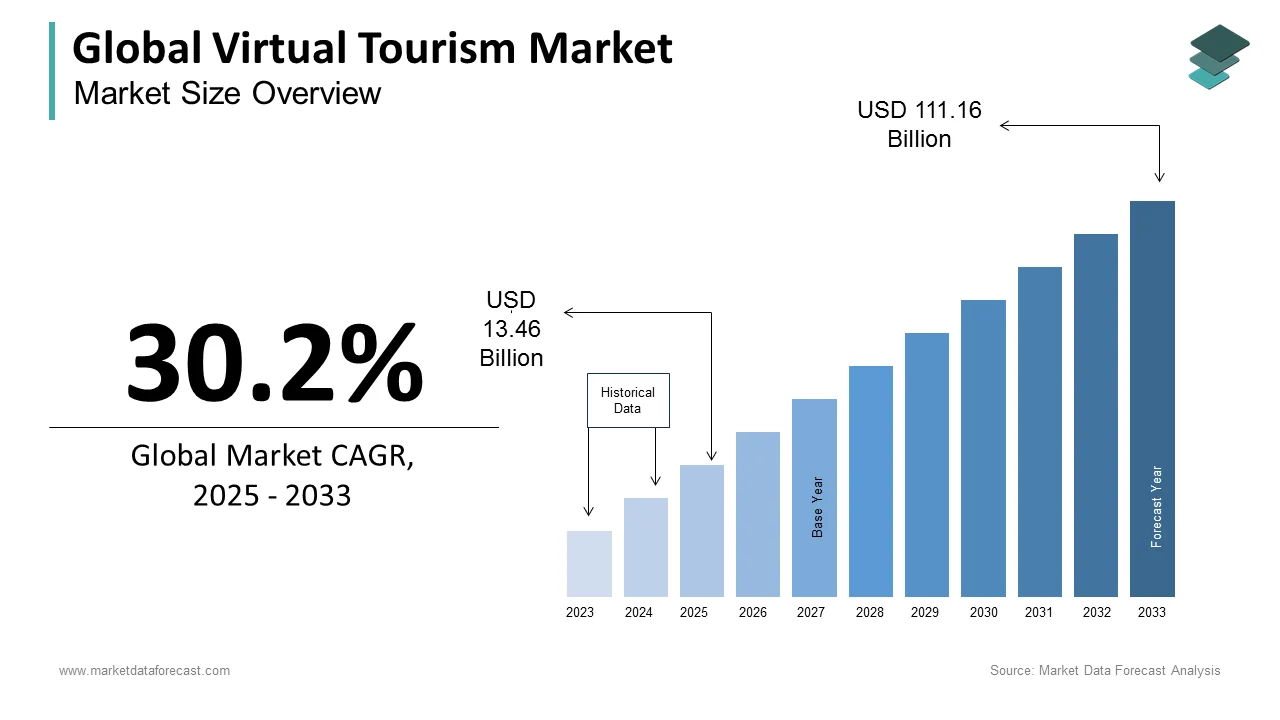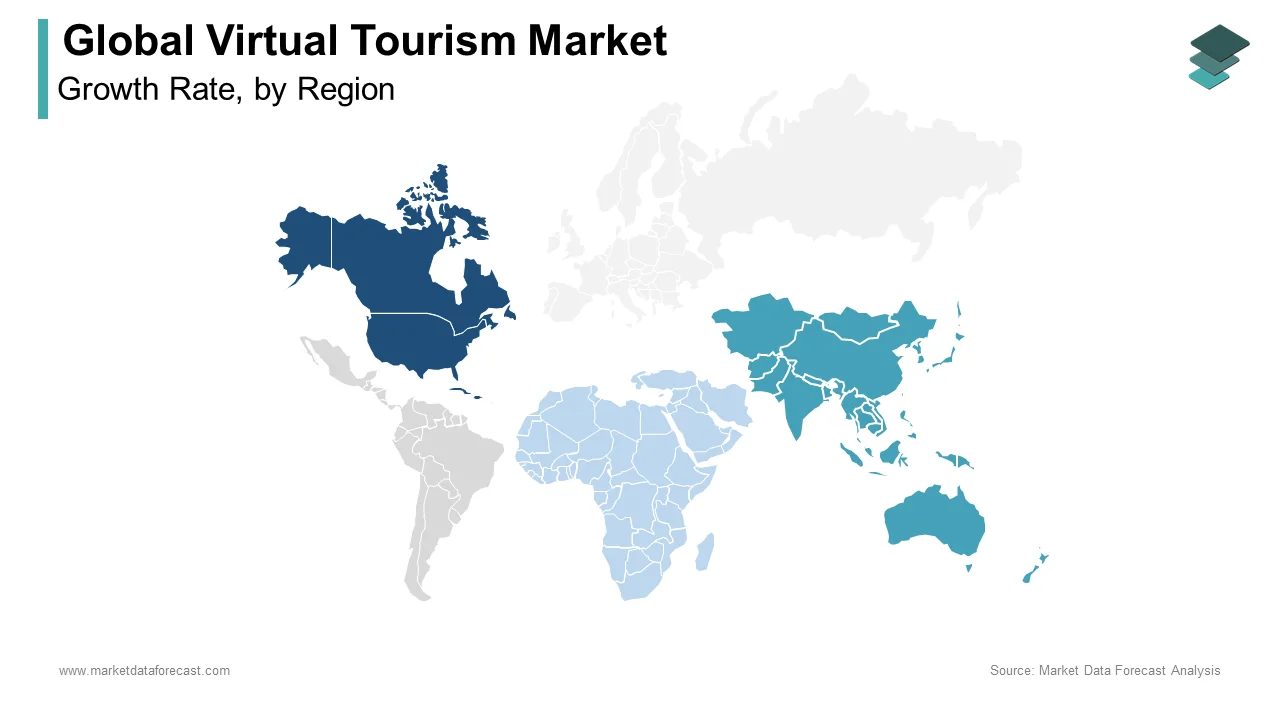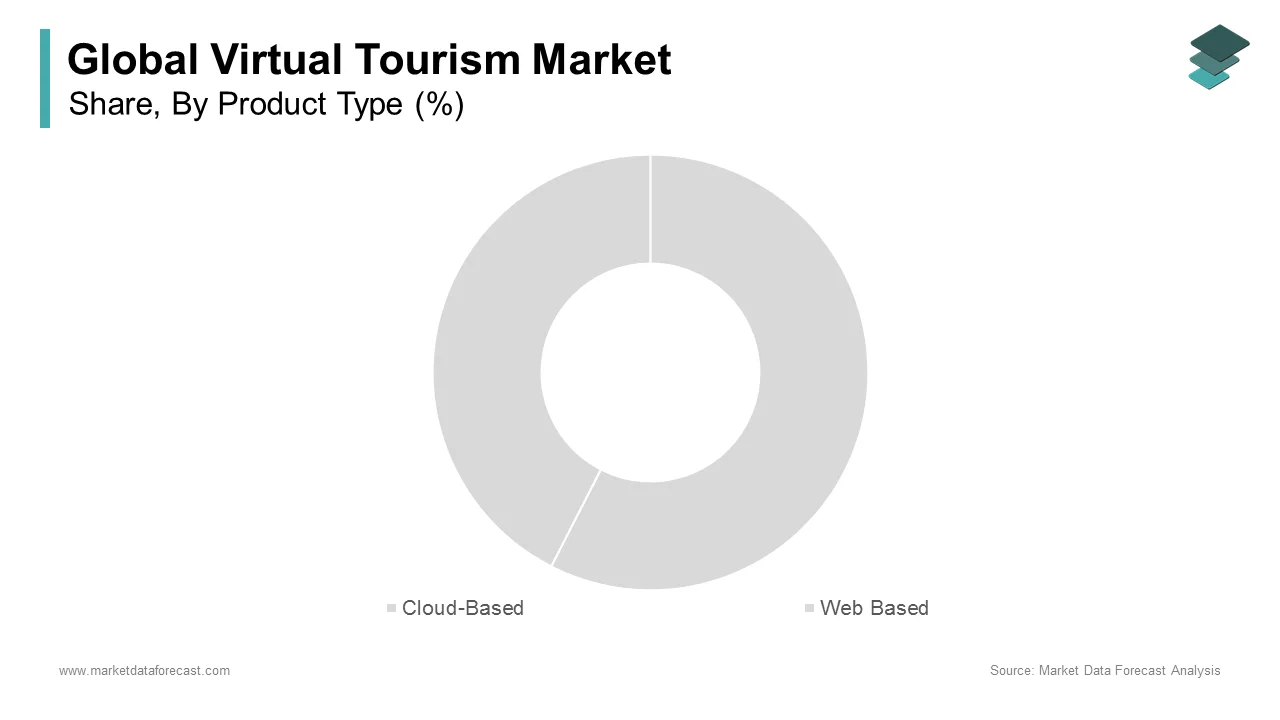Global Virtual Tourism Market Size, Share, Trends & Growth Forecast Report By Product Type (Cloud Based, Web Based), Device Type (Head Mounted, Gesture Tracking), Application (Real Estate Professionals, Tourism Industries, Marketing Professionals), and Region (North America, Europe, Asia-Pacific, Latin America, Middle East and Africa), Industry Analysis From 2025 to 2033.
Global Virtual Tourism Market Size
The Global virtual tourism market was worth US$ 10.34 billion in 2024 and is anticipated to reach a valuation of US$ 111.16 billion by 2033 from USD 13.46 billion in 2025 and is predicted to register a CAGR of 30.2% during the forecast period 2025 to 2033.

A virtual tour is a collection of panoramic photos that are stitched together to create a virtual experience of an area. This technology allows viewers to have an immersive exposure to a location, activity, or destination. Preschool & Childcare Virtual Tour, for example, or a 3D virtual tour for real estate. Many companies offering products and services in the worldwide virtual tour market are competing against one another to be competitive. They offer items that are both affordable and feature-rich. Some focus on SaaS-enabled cloud-based virtual tour platforms, while others offer web-based virtual tour platforms. Real estate brokers, photographers, businesses, and others are attracted to their well-designed and advanced featured items.
The tourism sector has reached a low point because of the COVID-19 pandemic. It will continue to suffer the consequences for a long time. Travel will triumph over post-pandemic concerns, necessitating the aviation and tourism industries' development of safer infrastructure and policies that ensure the safety of passengers. Travel booking websites, movies, blogs, and travel photography have all helped travel and tourism businesses expand their reach. People planning their next vacation list would find digital tools and content to be valuable sources of information. While remote tourism has always been a future topic in business forums, the world today, influenced by the COVID-19 epidemic, may now be ready to accept it.
Smart technology, such as virtual reality and robotics, not only improves other operational requirements like data collecting but also generates excitement around the organization, which can lead to great PR and brand positioning. This is backed up by an upsurge in VR patent filings in travel and tourism.
MARKET DRIVERS
Technological Advancements Boosting Virtual Tourism
The global virtual tourism market industry is being propelled forward by Blockchain technology, which is transforming the BFSI and supply chain management industries. The virtual tour impacting psychological well-being (virtual tour experience to alleviate tension and anxiety during and after the epidemic) has also become a crucial market influencer. Furthermore, the global virtual tourism market growth is expected due to technological advancements, lower product costs, increased gaming and entertainment solutions, potential uses for virtual tours in healthcare, advanced headsets, and display units, 5G and other advanced networks, and potential uses for virtual tours in healthcare.
The principle of "try before you buy" is currently being used in the travel and tourist business. Travel and tourism companies are investing in augmented reality and virtual reality to improve the consumer experience. Using AR and VR technology, a variety of apps are being developed to allow clients to experience the real-time scenario of a place they want to book. Companies in the travel and tourism sector are investing in AR VR to improve their services and product offerings in order to provide tourists with a wonderful trip experience.
MARKET RESTRAINTS
Limited Authentic Experience in Virtual Tourism
Virtual tourism is simply a reproduction of reality, no matter how you look at it. You experience this reality/world via the creator's "eyes" and may miss important details. Often, the creator has a goal in mind and designs the tour accordingly. The user may not actually experience the real essence of the location. Moreover, virtual tourism does not bring in the same amount of money as a traditional tourist. Traditional tourism brings in a lot of money for the host site, and it's because of these profits that the areas even allow tourism. This is not the case with virtual tourism, as not everyone has access to the necessary digital surfaces. One major disadvantage of virtual tourism is that it requires less social interaction. The energy and many of the traits that make the event distinctive are missed by the traveler. Moreover, it is also very costly and requires good internet connectivity at all locations.
REPORT COVERAGE
|
REPORT METRIC |
DETAILS |
|
Market Size Available |
2024 to 2033 |
|
Base Year |
2024 |
|
Forecast Period |
2025 to 2033 |
|
CAGR |
14.34% |
|
Segments Covered |
By Product Type, Device Type, Application, and Region. |
|
Various Analyses Covered |
Global, Regional & Country Level Analysis, Segment-Level Analysis, DROC, PESTLE Analysis, Porter’s Five Forces Analysis, Competitive Landscape, Analyst Overview of Investment Opportunities |
|
Regions Covered |
North America, Europe, APAC, Latin America, Middle East & Africa |
|
Market Leaders Profiled |
Google, Go Meta, Valve, Ximmerse, Samsung Electronics, Microsoft Corporation, Sony Interactive Entertainment, Oculus VR LLC, and Others. |
SEGMENT ANALYSIS
By Product Type Insights
Most companies opt for cloud-based virtual tourism software since it offers benefits such as real-time updates which make work faster and easier, flexible pricing policy, enhanced cooperation, and easy data recovery.
By Device Type Insights
The head-mounted display is the most immediately recognizable component of Virtual Reality (HMD). Visuals appeal more to humans, and thus the technology that separates immersive Virtual Reality systems from standard user interfaces is frequently the most bought.
By Application Insights
Currently, real estate professionals are the ones mostly using virtual reality tours to give their clients a view of the entire property even when they are sitting far away from the place. However, gradually tourism is also picking up pace.
REGIONAL ANALYSIS

Over the forecast period, North America is the global leader in the creation of VR and AR-related travel and tourism jobs. Over half (57%) of VR and AR jobs in the tourism industry are in the United States and Canada. Walt Disney is a firm in the United States that continues to put a heavy emphasis on virtual reality and augmented reality. Because this organization is significantly invested in the experience economy, it now has 201 active and 112 closed VR and AR jobs to ensure that customer experiences are always improved.
During the lockdown period, The German National Tourist Board used Quest Rift headsets to take guests on virtual tours of Germany and parts of its Baltic and the North Sea beaches.
Due to increased investments in AR VR in travel and tourism in the Asia Pacific area, the region is predicted to develop at a high CAGR throughout the forecast period.
A virtual reality park was launched in Dubai in 2018 to provide tourists with virtual games and activities. Dubai is a major tourist attraction in the Gulf region, and it was the fourth most visited in 2017. During the forecast period in the Middle East and Africa, the new VR park and other similar developments are likely to boost demand for AR VR in the travel and tourist ecosystem.
KEY MARKET PLAYERS
Companies playing a prominent role in the global virtual tourism market include Google, Go Meta, Valve, Ximmerse, Samsung Electronics, Microsoft Corporation, Sony Interactive Entertainment, Oculus VR LLC, and Others.
RECENT MARKET HAPPENINGS
- Cape Town has launched a virtual game that enables users to experience an adventurous activity belonging to the country via a virtual mode. They aim to revive the COVID-struck tourism industry via this new campaign.
- With the OPTU5G VR Track Tour, Optus is bringing the latest in VR technology to the Formula 1 Heineken Australian Grand Prix 2022, providing spectators with a unique opportunity to test their skills while getting a birds-eye perspective of Albert Park.
MARKET SEGMENTATION
This global virtual tourism market research report has been segmented and sub-segmented based on product type, device type, application, and region.
By Product Type
- Cloud-Based
- Web Based
By Device Type
- Head Mounted
- Gesture Tracking
By Application
- Real Estate Professionals
- Tourism Industries
- Marketing Professionals
By Region
- North America
- Europe
- Asia Pacific
- Latin America
- Middle East & Africa
Frequently Asked Questions
1. What is the virtual tourism market growth rate during the projection period?
The global virtual tourism market is expected to grow with a CAGR of 30.2% between 2025 and 2033.
2. What can be the total global virtual tourism market value?
The global virtual tourism market size is expected to reach a revised size of US$ 111.16 billion by 2033.
3. What are the top 5 key players in the global virtual tourism market?
Valve, Ximmerse, Samsung Electronics, Microsoft Corporation, and Sony Interactive Entertainment are top key players in the global virtual tourism market.
Related Reports
Access the study in MULTIPLE FORMATS
Purchase options starting from $ 2500
Didn’t find what you’re looking for?
TALK TO OUR ANALYST TEAM
Need something within your budget?
NO WORRIES! WE GOT YOU COVERED!
Call us on: +1 888 702 9696 (U.S Toll Free)
Write to us: [email protected]
